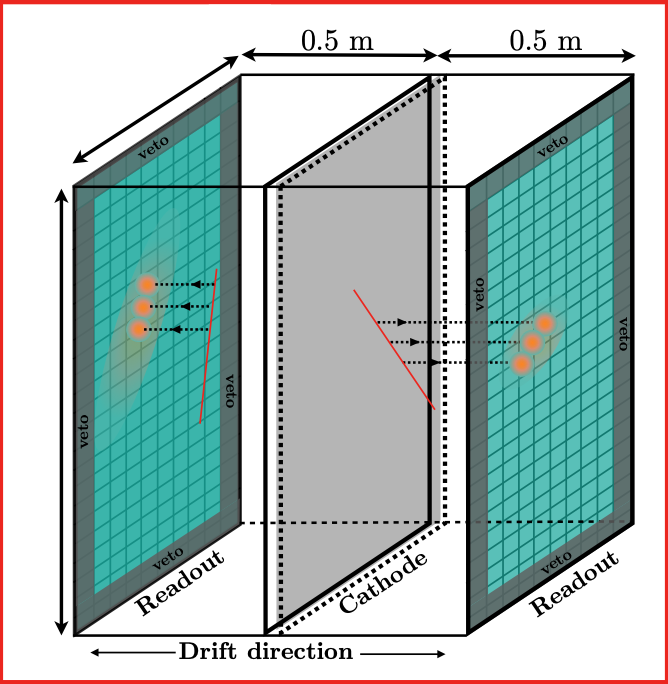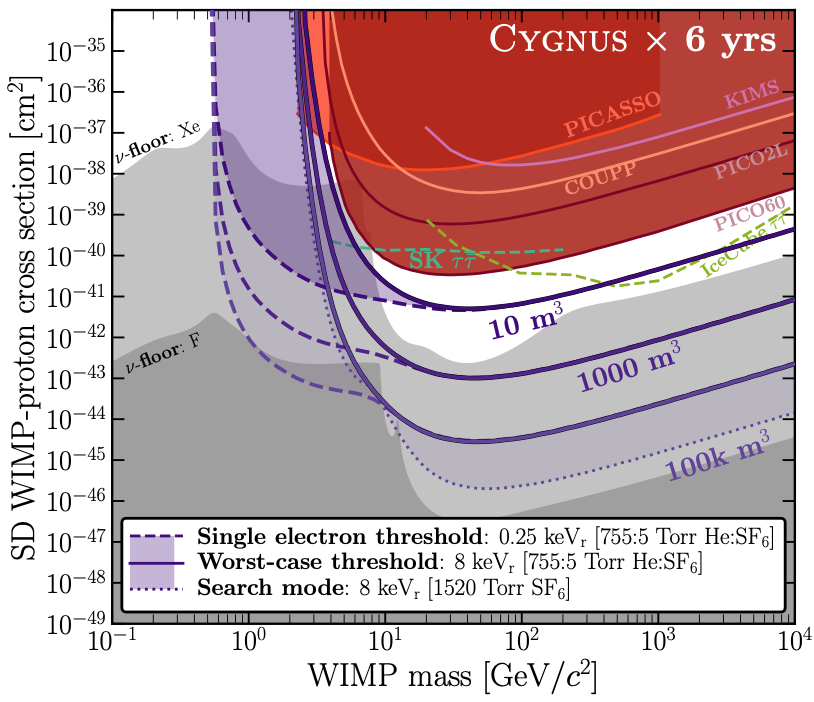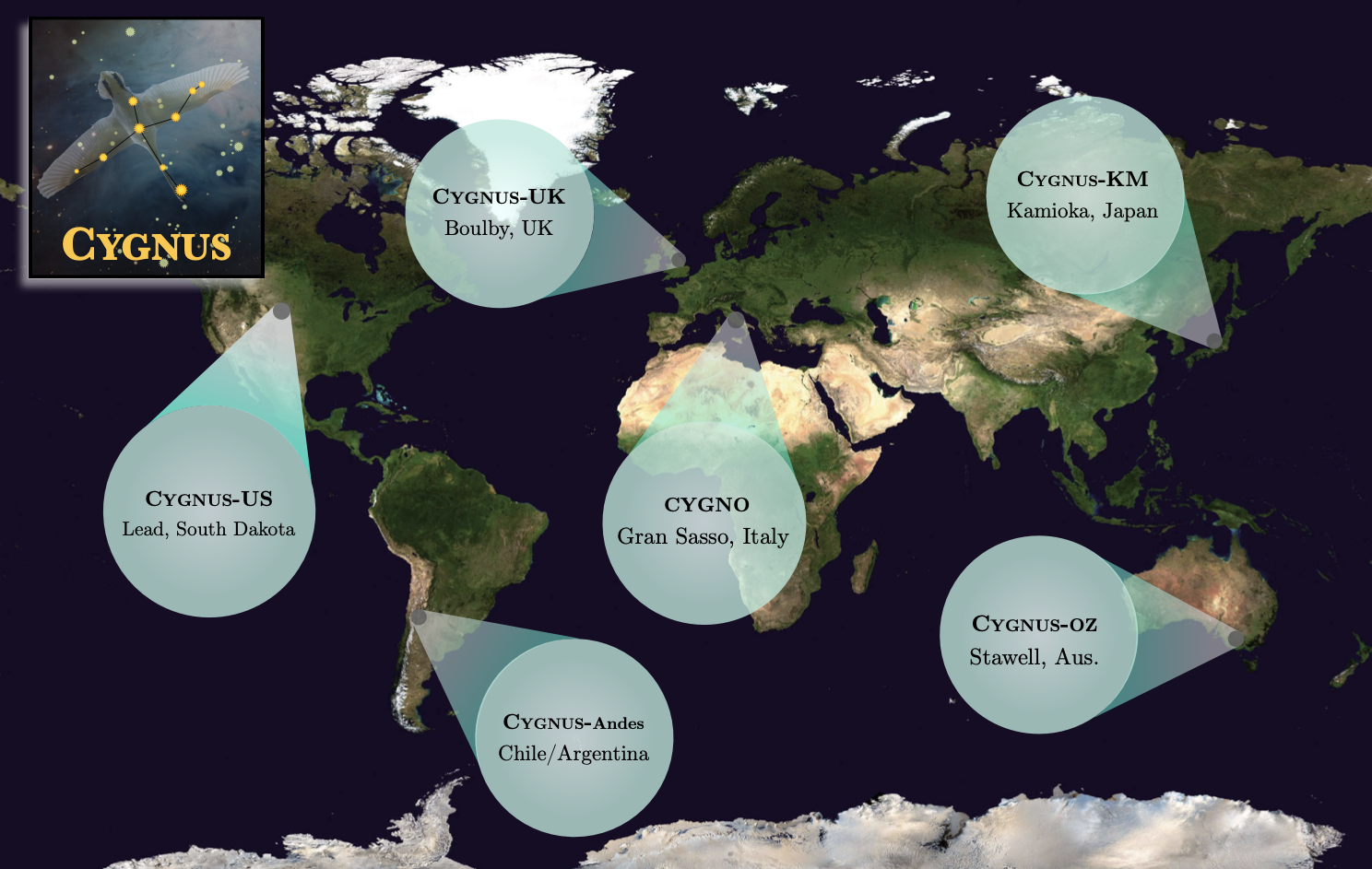New CYGNUS-Oz collaboration
CYGNUS is a grouping of international researchers who have an interest in directional detection using gaseous Time Projection Chambers (TPCs).
The main groups are located in the UK (Sheffield), Italy (GSSI and Frascati), Japan (Kobe) and the USA (Hawaii and New Mexico).
Australian involvement started around 2016 and in the original ARC Centre of Excellence for Dark Matter Particle Physics proposal CYGNUS was envisaged as an R&D effort that could eventually lead to a full-scale experiment to operate in SUPL after SABRE completed its experimental program.
The most sensitive dark matter detectors are approaching the level where they will become sensitive to coherent neutrino-nucleus scattering. With vast quantities of background neutrinos washing through detectors, these neutrino signals may swamp the signals of interest caused by WIMP-nucleus scattering. The significance of CYGNUS is that, in principle, it enables the search for WIMP dark matter to extend below this neutrino floor.
With a gas TPC, the ionisation track from a recoiling nucleus is swept out by an applied electric field and can be 3D imaged through the use of a 2D readout plane for X/Y information, while the time of arrival of the charge gives the Z information.
This, in principle, provides the direction of the recoiling nucleus and through kinematic reconstruction, the potential direction of the incoming particle, either WIMP or neutrino. A potential 10m^3 module of a future CYGNUS detector is shown schematically in Figure 1. A unique feature of a gas TPC is the ability to use different gases and provide spin-dependent WIMP sensitivity.
Figure 2 shows that a 10m^3 detector with a realistic nuclear recoil energy threshold can have world-leading sensitivity.
Since most neutrinos are expected to come from the sun, while WIMPs are expected to come from the direction in which the earth is moving through the Milky Way galaxy (towards CYGNUS), a spatial separation of the WIMP signals from the background neutrinos would be possible.
Significant R&D is required to obtain the low energy threshold and high resolution track information that will enable this separation in reality. The feasibility of the CYGNUS concept is discussed in a number of recent papers, including reviews by Vahsen et al ("CYGNUS: Feasibility of a nuclear recoil observatory with directional sensitivity to dark matter and neutrinos",) and O'Hare et al ("Recoil imaging for directional detection of dark matter, neutrinos, and physics beyond the Standard Model",).
It is of the utmost importance that the major aim of experimental effort in WIMP direct detection in the Centre is focussed on bringing SABRE to completion. In the longer term, the next evolution of WIMP direct detection at SUPL might end up being a gas TPC as part of an international network of directional detectors (see Figure 3). With this in mind, a group of local researchers from Adelaide, ANU, Melbourne and Sydney have come together to form the CYGNUS-Oz collaboration. The present group comprises 9 senior academics, 6 EMCRs and 3 PhD students.
An institutional board of Paul Jackson (Adelaide), Greg Lane (ANU), Nicole Bell (Melbourne) and Ciaran O'Hare (Sydney) has been elected to coordinate efforts, with Greg being elected as the CYGNUS-Oz Chair.
Three local working groups and their coordinators have also been
established: Experiment (Lindsey Bignell, ANU), Theory (Ciaran O'Hare,
Sydney) and Simulation/Reconstruction/Analysis (Martin White, Adelaide).
Interest from additional researchers wishing to join CYGNUS-Oz would be welcome.
At present the theoretical effort is led out of Sydney and Melbourne, while the experimental effort is led out of ANU where a prototype TPC is currently being tested. In the next step we hope to extend the experimental effort to Adelaide with an evolutionary TPC design to operate at each institution investigating the important parameters such as ionisation, charge diffusion, negative-ion drift gases, gas purification, radioactive contamination, optical readouts, segmented anode readout technologies etc. These experimental advances, further theoretical insight, advanced track reconstruction and analysis methods, and collaboration with our international colleagues, will all be required to optimise the operation and sensitivity of future large scale CYGNUS detector modules.



